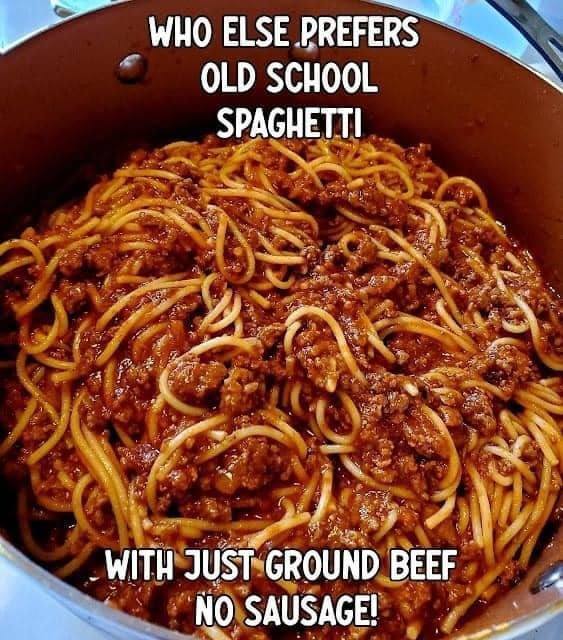ADVERTISEMENT
#### **Instructions:**
1. **Cook the Spaghetti**
– Bring a large pot of salted water to a boil. Add the spaghetti and cook according to the package instructions until al dente. Be sure not to overcook the pasta, as it should still have a firm bite.
– Once cooked, reserve about 1 cup of pasta water before draining the spaghetti. This starchy water can be used to adjust the consistency of the sauce later if needed.
2. **Prepare the Sauce**
– While the pasta is cooking, heat the olive oil in a large skillet over medium heat. Once hot, add the sliced garlic and sauté for 1-2 minutes until fragrant. Be careful not to let the garlic brown, as this will make it bitter.
– Add the tomato paste to the skillet and stir it into the garlic and olive oil, cooking for 2-3 minutes. This will deepen the flavor of the paste.
– Crush the whole tomatoes by hand or use a wooden spoon to break them up directly in the skillet. Add the crushed tomatoes (with their juices) to the pan, followed by a pinch of salt and freshly cracked black pepper.
– Simmer the sauce over low to medium heat for 15-20 minutes, stirring occasionally. The sauce should thicken and develop a rich, savory flavor. If the sauce becomes too thick, add a little reserved pasta water to reach your desired consistency.
3. **Toss the Pasta**
– Once the sauce is ready, add the cooked spaghetti directly into the skillet with the sauce. Toss the pasta in the sauce to coat it evenly, adding a bit of the reserved pasta water if needed to help the sauce cling to the noodles.
– Tear the fresh basil leaves into the sauce, stirring them in to release their aroma.
4. **Finish and Serve**
– Once the pasta is fully coated and the sauce has been absorbed, remove from heat. Divide the spaghetti among serving plates and top with a generous amount of grated Parmesan or Pecorino Romano.
– If you prefer a bit of heat, sprinkle some crushed red pepper flakes on top.
– Serve immediately, and enjoy your old-school spaghetti just as the Italians intended.
### Tips for Perfecting Your Old-School Spaghetti
– **Use High-Quality Tomatoes:** The key to a great tomato sauce is using the best tomatoes you can find. San Marzano tomatoes are widely considered the gold standard for spaghetti sauce, but any high-quality canned tomatoes will do.
– **Don’t Overcook the Pasta:** Al dente pasta has the best texture and holds the sauce better. Be sure to check the pasta a minute or two before the package instructions say it’s done.
– **Use Pasta Water:** The starchy pasta water helps the sauce adhere to the noodles and creates a smooth, silky texture. Don’t forget to reserve a cup before draining the pasta.
– **Customize the Sauce:** While traditional old-school spaghetti is made with a simple tomato sauce, you can customize it with additional ingredients like sautéed onions, ground meat, or olives for a heartier dish.
– **Add Fresh Herbs:** Fresh basil is essential to old-school spaghetti, but feel free to experiment with other herbs like oregano or thyme for different flavor profiles.
– **Grate the Cheese Fresh:** Pre-grated cheese can often be dry and lack flavor. Grating Parmesan cheese fresh adds a creaminess and richness to the dish that pre-grated versions can’t match.
### Variations on Old-School Spaghetti
While the traditional version of old-school spaghetti is a classic, there are many delicious variations you can try depending on your tastes and dietary preferences
. Here are a few ideas:
– **Spaghetti Bolognese:** Add ground beef or pork to the sauce for a rich, meaty version of spaghetti. Simmer the meat with the tomatoes and seasonings to create a savory, hearty sauce.
– **Spaghetti Aglio e Olio:** For a simpler, lighter version, sauté garlic in olive oil and toss the pasta with the oil, garlic, and a sprinkle of red pepper flakes. This minimalist version of spaghetti is full of flavor.
– **Vegetarian Spaghetti:** Skip the meat and make a delicious vegetable-based spaghetti by adding roasted or sautéed vegetables like zucchini, mushrooms, or eggplant.
– **Seafood Spaghetti:** Add shrimp, mussels, or clams to the sauce for a seafood-inspired version of spaghetti. The briny flavors of the seafood pair beautifully with the rich tomato sauce.
### Conclusion
Old-school spaghetti is more than just a meal—it’s a symbol of comfort, tradition, and the heart of Italian cooking. With just a few simple ingredients, you can create a dish that is full of flavor, texture, and nostalgia. Whether you’re cooking for your family, hosting a dinner party, or simply craving a classic Italian meal, this timeless recipe will never disappoint. So, gather your ingredients, follow the steps, and indulge in the rich flavors of old-school spaghetti—a dish that continues to bring joy to tables around the world.
